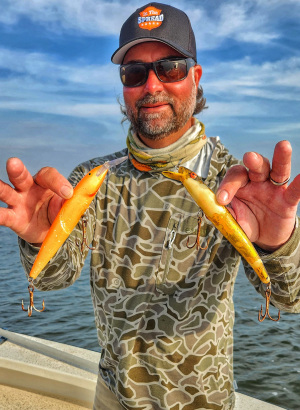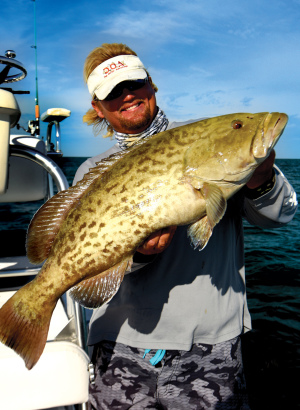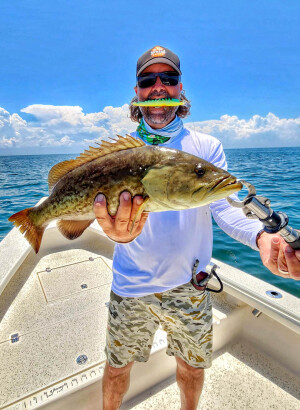Grouper are prized sport fish in Florida offering anglers exhilarating battles and delicious fillets. This comprehensive guide covers everything you need to know about fishing for the many species of grouper, from tackle and techniques to seasons and regulations.
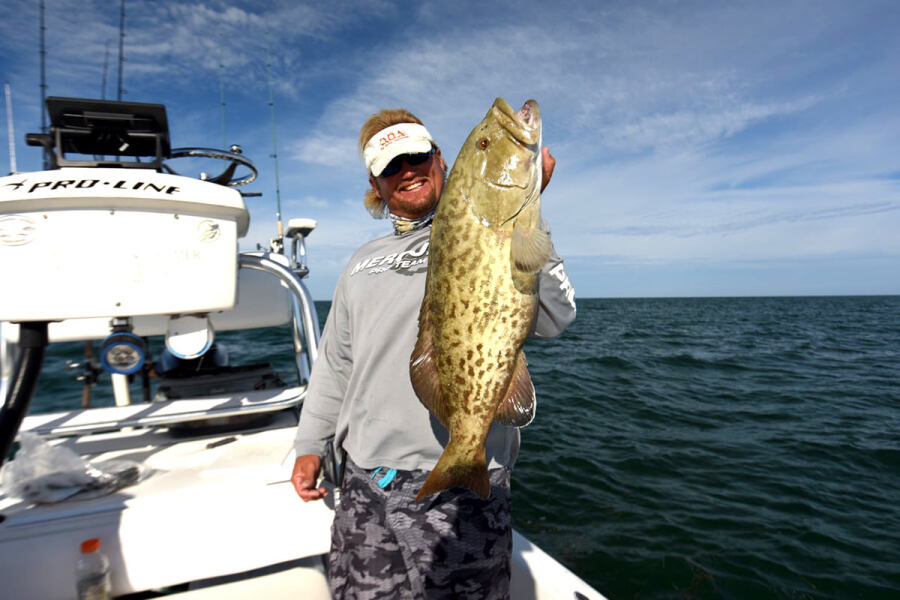
Florida Grouper - Prized Sport Fish
Key Points of the Article
- Types of grouper: Some of the most common and sought-after species in Florida are black, gag, goliath, red, snowy, and yellowedge grouper. Each species has its own distinctive features, habitat, and behavior.
- Grouper fishing in Florida: Fishing can be done in various locations, depending on the species and season. Some of the best places to fish for grouper are the Atlantic coast, the Florida Keys, Miami, the Gulf of Mexico, Tampa Bay, Crystal River, and Destin.
- Grouper fishing tackle: Setups vary depending on the depth, current, and size of the fish. Generally, heavy-duty rods and reels, braided line, circle hooks, and sinkers are recommended. Rigs can be either single or double hook, with or without a wire leader.
- Baits and lures for grouper: Presentations can be live, dead, or artificial. Live baits include pinfish, grunts, sardines, mullet, and crabs. Dead baits include squid, cut fish, and shrimp. Artificial lures include jigs, plugs, spoons, and soft plastics.
- Grouper fishing techniques: Much depends on the type of bait or lure used and the location of the fish. Some of the most common techniques are bottom fishing, trolling, deep dropping, and casting.
- Grouper Season Florida and Regulations: Regs vary by species and region. The Florida Fish and Wildlife Conservation Commission (FWC) sets the rules for recreational harvest of grouper in state waters. Anglers should always check with the FWC for the latest information before fishing for grouper in Florida.
Black Grouper
- Location: Florida's waters, especially around wrecks and rocks.
- Behavior: Strong fighters; known to dive deep and seek refuge.
- Tackle Needed: Heavy tackle and patience.
- Fishing Season: Specific grouper season in Florida for optimal catches.
From the emerald waters off Florida's coastline, a formidable adversary emerges, ready to challenge the most seasoned of anglers. This adversary is none other than the Black Grouper, a species that epitomizes the thrill and challenge of sport fishing in Florida.
A Closer Look at the Grouper
The grouper, specifically the Black Grouper (Mycteroperca bonaci), belongs to the family Serranidae. Characterized by its robust body and a broad mouth, this species can grow impressively large, making it a prized catch for many sport fishermen. Its mottled gray and dark coloration provides it with the perfect camouflage amidst the ocean floor's rocky terrains.
Florida's Grouper Domain
- Location is Key: Black groupers often frequent rocky outcrops and submerged wrecks. A good knowledge of the ocean floor topology can significantly increase your chances.
- Equip Yourself Right: Given the grouper's notorious reputation for being strong fighters, it's imperative to arm oneself with heavier tackle.
- Patience Pays: Once hooked, the grouper can dive deep, seeking refuge. Anglers should be patient and persistent.

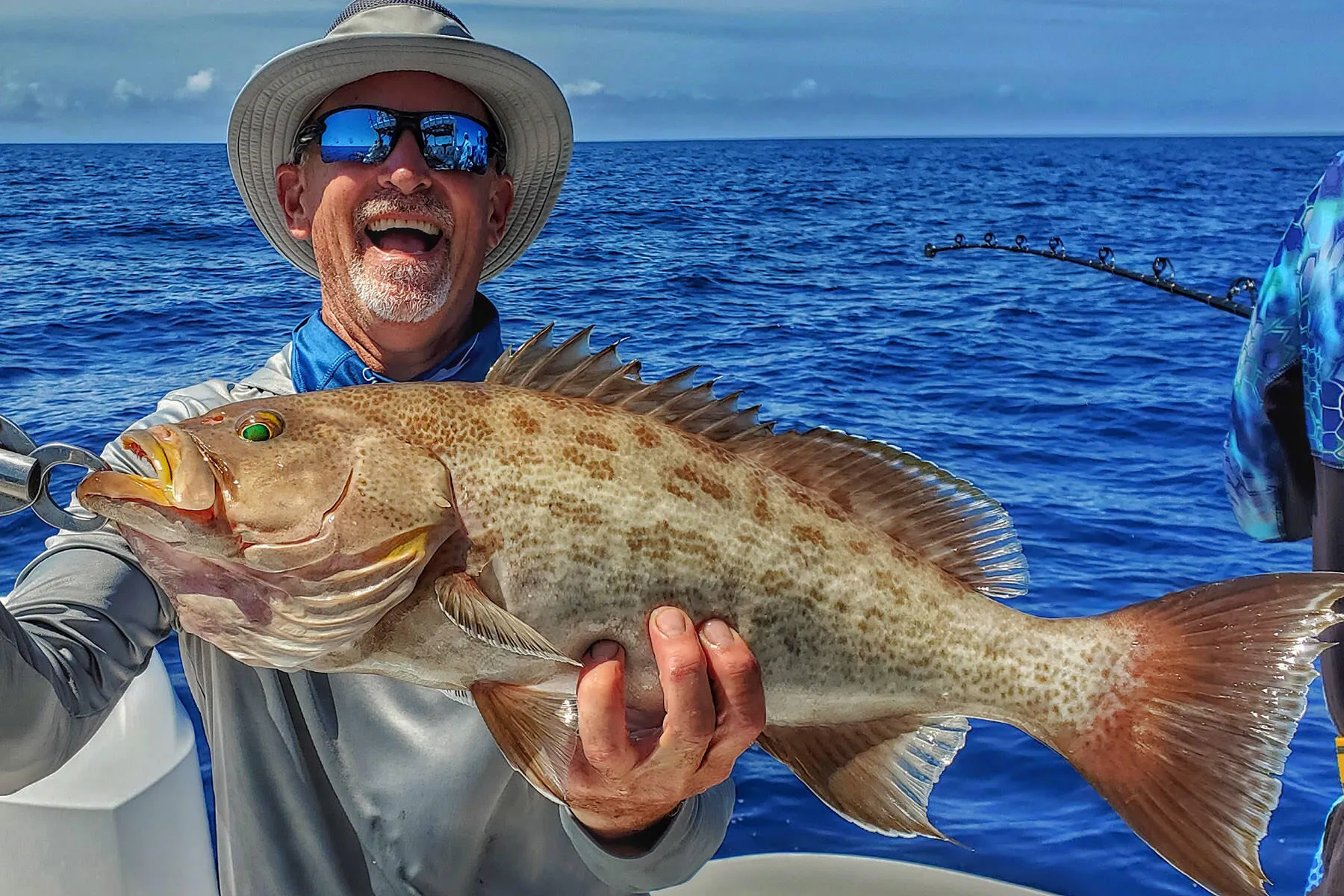
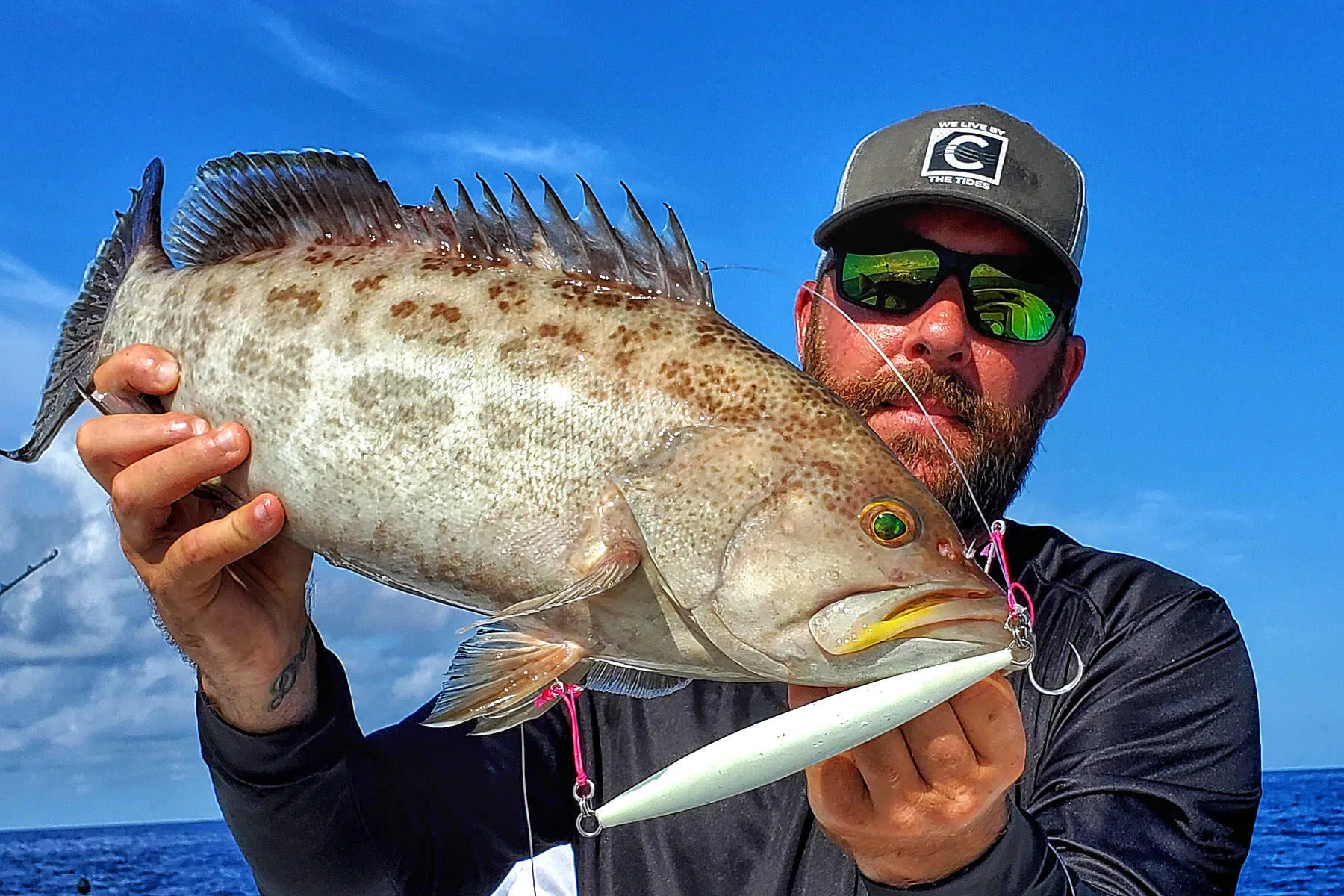
Gag Grouper
- Habitual Behavior: Aggressive fighters; prone to seek cover.
- Angler's Challenge: Powerful jaws can sever lines; necessitates heavy tackle and finesse.
- Prime Locale: Florida's abundant coasts.
- Best Time: The much-anticipated grouper season in Florida.
Diving into the Science
The Gag Grouper, known scientifically as Mycteroperca microlepis, is a member of the Serranidae family. A formidable fish, it boasts a sleek, elongated body, and its camouflage pattern blends seamlessly with the ocean's rocky bottom.
To understand a fish like the gag grouper is to unravel the very fabric of Florida's sport fishing soul.
Seth HorneFlorida: The Grouper's Playground
- Anticipate Their Moves: Gag groupers are known for their swift runs towards cover. Being a step ahead can be the difference between a catch and a miss.
- Gear Up: Their jaws, a marvel of nature, can easily cut through lines. Arm yourself with heavier tackle.
- Master the Skill: Beyond equipment, it's the angler's skill and intuition that often tilt the odds in their favor.
The Dance of Predator and Prey
The predatory behavior of the gag grouper is a spectacle in itself. Their aggressive nature, coupled with their innate ability to ambush prey, makes them a force to reckon with. For the sport fisherman, this dance of predator and prey, of hide and seek, is what makes the pursuit truly exhilarating.
Goliath Grouper
- Characteristic Behavior: Mighty fighters; capable of breaking fishing equipment.
- Unique Feature: Gigantic mouths swallowing sizable baits.
- Fishing Essentials: Heavy-duty tackle and a bold heart.
- Prominent Region: Florida's bountiful coastal waters.
- Peak Time: The renowned grouper season in Florida.
An Academic Glimpse
Epinephelus itajara, commonly recognized as the Goliath Grouper, is a prodigious member of the Serranidae family. With a stout body structure and a vast mouth, it is one of the ocean's most impressive spectacles.
Florida's Grouper Chronicles
- Be Prepared: Expect sudden, powerful tugs. This fish can effortlessly snap lines and rods.
- Choose the Right Bait: Their cavernous mouths can engulf large lures, so opt for sizable baits.
- Courage is Key: Beyond the equipment, it's the angler's bravery and determination that often determine the outcome.
Nature's Mighty Predator
The predatory prowess of the goliath grouper is nothing short of awe-inspiring. Their method of ambushing prey, combined with their sheer physical strength, makes them a dominant force in their habitat. For the recreational fisherman, locking horns with this titan becomes a story for the ages.
Red Grouper
- Combat Nature: Though less forceful than kin, they resist with tenacity.
- Defense Tactic: Known to burrow into the seabed, complicating the catch.
- Angler's Arsenal: Medium to heavy tackle coupled with relentless spirit.
- Prime Territory: Florida's diverse marine landscapes.
- Optimal Time: The much-touted grouper season in Florida.
A Scientific Perspective
Hailing from the Serranidae lineage, the Red Grouper, or Epinephelus morio, stands out with its reddish-brown hue and intricate patterns. This fish, though not the mightiest, carries an aura of understated strength.
Florida: A Mosaic of Grouper Tales
- Anticipate the Dive: Red groupers have a penchant for embedding themselves in the ocean floor. Being prepared for this move can tip the scales in the angler's favor.
- Equip Wisely: A combination of medium to heavy tackle is recommended to counter the grouper's tenacity.
- Persistence Pays: Though they might not match the brute force of their cousins, red groupers require consistent effort to land.
Snowy Grouper
- Fishing Challenge: Lives in profound depths; considerable size.
- Equipment Mandate: Specialized tackle tailored for depth and weight.
- Angler's Prerequisite: Heavy tackle combined with seasoned expertise.
- Heartland: Florida's deep-sea fishing zones.
- Prime Time: The much-awaited grouper season in Florida.
A Dive into Scientific Nuances
The Snowy Grouper, bearing the scientific name Hyporthodus niveatus, is an exquisite member of the grouper family. With its dark, brooding shades punctuated by white specks, it mirrors a starry night, making it a sight to behold.
The depths conceal many a secret, and among them, the Snowy Grouper is Florida's best-kept.
Grouper MafiaFlorida's Deep-Sea Chronicles
- Depth Mastery: Snowy Groupers reside in profound depths, demanding specialized techniques and understanding.
- Choose the Right Gear: Given the fish's formidable size, heavy-duty tackle becomes indispensable.
- Rely on Expceriene: Beyond equipment, an angler's wisdom and previous encounters play a pivotal role.
Yellowedge Grouper
- Challenges in Capture: Resides in profound depths; notable rarity.
- Distinct Feature: Sharp teeth capable of shearing through fishing lines.
- Equipment Requirement: Heavy tackle complemented by a dash of good fortune.
- Fishing Heartland: Florida's mysterious deep waters.
- Seasonal Peak: The much-anticipated grouper season in Florida.
A Glimpse into the Scientific Realm
Belonging to the intricate tapestry of the grouper family, the Yellowedge Grouper, scientifically termed Hyporthodus flavolimbatus, is a vision in contrasts. Its muted body juxtaposed against the vivid yellow edges makes it a mesmerizing sight.
The Yellowedge Grouper is a testament to nature's penchant for concealing its most wondrous creations in the depths.
Seth HorneFlorida: The Deep-Sea Theatre
- Venture Deep: The Yellowedge is a denizen of the abyss, necessitating specialized deep-sea angling techniques.
- Arm Yourself: Possessing teeth that can effortlessly slice through lines, heavy-duty tackle is non-negotiable.
- Invoke the Fishing Gods: Given their rarity, a sprinkle of luck often proves invaluable.


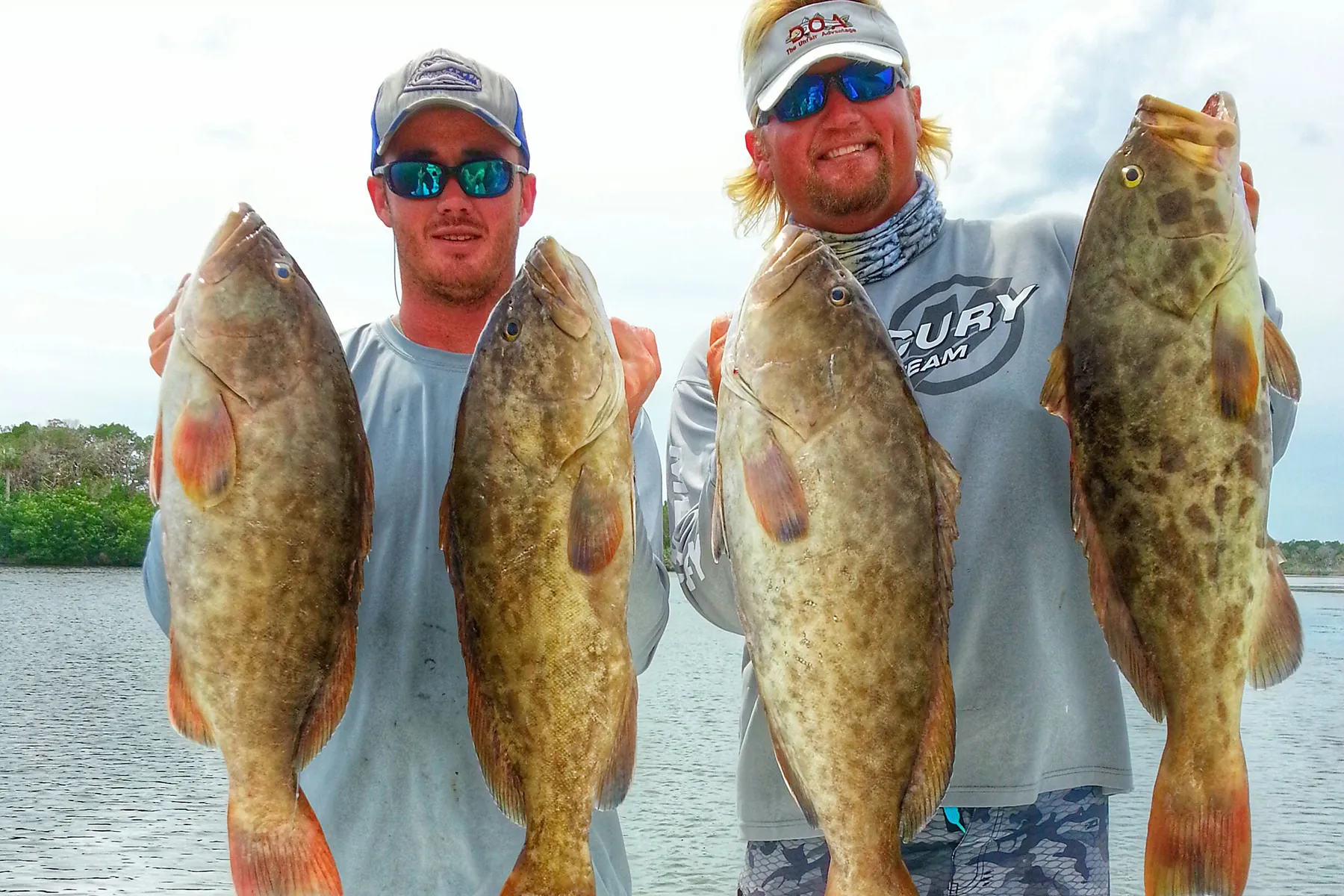
Grouper Fishing in Florida
Best Grouper Fishing Locations in Florida
- Florida Keys: The Florida Keys are a chain of islands that stretch from Key Largo to Key West. The Keys have a rich and diverse marine life, including many species of grouper. You can find black, gag, red, and snowy grouper in the reefs and wrecks around the Keys. Some of the best spots to fish for grouper in the Keys are Molasses Reef, Alligator Reef, Sombrero Reef, and Vandenberg Wreck.
- Miami: Miami is a major city that lies on the southeastern tip of Florida. Miami has a vibrant and cosmopolitan culture, as well as a thriving fishing scene. You can find black, gag, red, and snowy grouper in the offshore waters of Miami. Some of the best spots to fish for grouper in Miami are Fowey Rocks, Triumph Reef, Ajax Reef, and Stiltsville.
- Tampa Bay: Tampa Bay is a large natural harbor that lies on the west-central coast of Florida. Tampa Bay has a diverse and productive ecosystem that hosts many species of grouper. You can find black, gag, goliath, red, snowy, and yellowedge grouper in the bay and offshore waters of Tampa Bay. Some of the best spots to fish for grouper in Tampa Bay are Skyway Bridge, Egmont Key, Fort De Soto Park, and Clearwater Beach.
- Crystal River: Crystal River is a small city that lies on the west-central coast of Florida. Crystal River is famous for its clear and spring-fed waters that attract manatees and other wildlife. You can find black, gag, goliath, red, snowy, and yellowedge grouper in the nearshore and offshore waters of Crystal River. Some of the best spots to fish for grouper in Crystal River are Homosassa Springs, Kings Bay, Crystal River Preserve State Park, and Yankeetown Reef.
- Destin: Destin is a popular tourist destination that lies on the northwest coast of Florida. Destin is known for its white sand beaches and emerald green waters that offer some of the best fishing in the Gulf. You can find black, gag, goliath, red, snowy, and yellowedge grouper in the offshore waters of Destin. Some of the best spots to fish for grouper in Destin are Destin Bridge, Destin Pass, Destin East Jetty, and Destin Rocks.
Grouper Fishing Tackle
Rods and Reels
- Length: The length of the rod should match the fishing technique and the size of the fish. For bottom fishing, a shorter rod (6 to 7 feet) is preferred, as it gives more leverage and control over the fish. For trolling, a longer rod (7 to 9 feet) is preferred, as it gives more flexibility and shock absorption. For casting, a medium-length rod (7 to 8 feet) is preferred, as it gives more accuracy and distance.
- Power: The power of the rod refers to its strength or stiffness. For grouper fishing, a heavy or extra-heavy power rod is preferred, as it can handle the weight and pull of the fish. A lighter power rod may bend too much and break under pressure.
- Action: The action of the rod refers to its bending curve or speed. For grouper fishing, a fast or extra-fast action rod is preferred, as it has a stiffer tip and a faster recovery. A slower action rod may be too soft and slow to set the hook and fight the fish.
- Material: The material of the rod affects its durability and performance. For grouper fishing, a graphite or composite rod is preferred, as it is strong, light, and sensitive. A fiberglass rod may be too heavy and dull for grouper fishing.
- Reel Type: The reel type for grouper fishing depends on the fishing technique and the depth of the water. For bottom fishing, a conventional or baitcasting reel is preferred, as it has more line capacity and drag power. For trolling, a conventional or spinning reel is preferred, as it has more speed and smoothness. For casting, a spinning or baitcasting reel is preferred, as it has more accuracy and versatility.
- Reel Size: The reel size for grouper fishing depends on the size of the fish and the line strength. For grouper fishing, a large or extra-large reel is preferred, as it can hold more line and handle more pressure. A smaller reel may not have enough line or drag to land a big grouper.
- Reel Gear Ratio: The reel gear ratio refers to the number of times the spool rotates for each turn of the handle. For grouper fishing, a low or medium gear ratio (4:1 to 6:1) is preferred, as it gives more torque and power. A high gear ratio (7:1 or higher) may be too fast and weak for grouper fishing.
Rods and Reels for Different Grouper Fishing Applications
- Bottom Fishing: A 6 to 7 foot heavy or extra-heavy power fast or extra-fast action graphite or composite rod with a conventional or baitcasting reel with a low or medium gear ratio (4:1 to 6:1), a large or extra-large size (5000 to 10000), and a braided line of 50 to 100 pounds.
- Trolling: A 7 to 9 foot heavy or extra-heavy power fast or extra-fast action graphite or composite rod with a conventional or spinning reel with a low or medium gear ratio (4:1 to 6:1), a large or extra-large size (5000 to 10000), and a braided line of 50 to 100 pounds.
- Casting: A 7 to 8 foot heavy or extra-heavy power fast or extra-fast action graphite or composite rod with a spinning or baitcasting reel with a low or medium gear ratio (4:1 to 6:1), a large or extra-large size (5000 to 10000), and a braided line of 50 to 100 pounds.
Grouper Fishing Rigs
Hooks for Grouper
- Hook Type: The hook type for grouper fishing depends on the type of bait or lure used and the size of the fish. For grouper fishing, a circle hook is preferred, as it has a curved point that hooks the fish in the corner of the mouth and prevents gut hooking. A J hook may be too straight and pierce the fish in the stomach or throat, causing injury or death.
- Hook Size: The hook size for grouper fishing depends on the size of the bait or lure and the size of the fish. For grouper fishing, a large or extra-large hook is preferred, as it can match the size of the bait or lure and penetrate the mouth of the fish. A smaller hook may be too small and miss the bite or slip out of the mouth of the fish.
Leaders
- Leader Type: The leader type for grouper fishing depends on the depth, current, and visibility of the water. For grouper fishing, a fluorocarbon or wire leader is preferred, as it is more abrasion-resistant and less visible than a monofilament leader. A fluorocarbon leader is more flexible and natural-looking than a wire leader, but it may not be strong enough to withstand the teeth of some grouper species. A wire leader is more rigid and artificial-looking than a fluorocarbon leader, but it may be necessary to prevent the fish from biting through the line.
- Leader Length: The leader length for grouper fishing depends on the type of bait or lure used and the behavior of the fish. For grouper fishing, a short or medium leader (2 to 6 feet) is preferred, as it gives more control and stability over the bait or lure. A longer leader (6 feet or more) may be too loose and allow the bait or lure to drift away from the target zone or get tangled in the rocks or wrecks.
Weights
- Sinker Type: The sinker type for grouper fishing depends on the depth, current, and bottom structure of the water. For grouper fishing, a pyramid, bank, or egg sinker is preferred, as it has a streamlined shape that sinks fast and holds well in the bottom. A ball or barrel sinker may be too round and roll around in the current or get stuck in the rocks or wrecks.
- Sinker Weight: The sinker weight for grouper fishing depends on the depth, current, and line strength of the water. For grouper fishing, a heavy or extra-heavy sinker (4 to 16 ounces) is preferred, as it can reach and maintain the desired depth and position in the water. A lighter sinker (1 to 3 ounces) may not be enough to overcome the resistance of the water or keep the bait or lure in place.
Rigs for Grouper
- Single Hook Rig: A single hook rig consists of a circle hook attached to a fluorocarbon or wire leader with a swivel and a pyramid, bank, or egg sinker. This rig is simple and effective for bottom fishing with live or dead baits such as pinfish, grunts, sardines, mullet, squid, cut fish, or shrimp.
- Double Hook Rig: A double hook rig consists of two circle hooks attached to a fluorocarbon or wire leader with a swivel and a pyramid, bank, or egg sinker. This rig is similar to a single hook rig but allows for two baits or lures to be used at once. This rig is useful for bottom fishing with live or dead baits such as pinfish, grunts, sardines, mullet, squid, cut fish, or shrimp.
- Jigging Rig: A jigging rig consists of a jig head with a soft plastic tail attached to a fluorocarbon or wire leader with a swivel and an optional pyramid, bank, or egg sinker. This rig is designed for vertical jigging with artificial lures such as jigs, spoons, soft plastics, or plugs.
Baits and Lures for Grouper
- Type: The type of bait or lure for grouper fishing depends on the preference and availability of the fish. For grouper fishing, live, dead, or artificial baits or lures can be used. Live baits are more natural and realistic than dead or artificial baits, but they may be harder to obtain and keep alive. Dead baits are more convenient and cheaper than live or artificial baits, but they may not be as fresh or appealing. Artificial lures are more versatile and reusable than live or dead baits, but they may not be as effective or lifelike.
- Size: The size of the bait or lure for grouper fishing depends on the size of the hook and the size of the fish. For grouper fishing, a large or extra-large bait or lure is preferred, as it can match the size of the hook and attract the attention of the fish. A smaller bait or lure may be too small and unnoticed or swallowed whole by the fish.
- Color: The color of the bait or lure for grouper fishing depends on the visibility and mood of the fish. For grouper fishing, a bright or contrasting color is preferred, as it can stand out in the water and stimulate the curiosity of the fish. A dull or matching color may be too bland and ignored by the fish.
- Action: The action of the bait or lure for grouper fishing depends on the movement and behavior of the fish. For grouper fishing, a slow or erratic action is preferred, as it can mimic the motion of a wounded or dying prey and trigger the predatory instinct of the fish. A fast or steady action may be too unnatural and suspicious by the fish.
- Live Baits: Live baits are the most natural and realistic baits for grouper fishing. They can elicit a strong response from the fish, especially when they are fresh and lively. Some of the best live baits for grouper fishing are pinfish, grunts, sardines, mullet, and crabs. These baits can be hooked through the nose, mouth, back, or tail with a circle hook and a single or double hook rig.
- Dead Baits: Dead baits are more convenient and cheaper than live baits for grouper fishing. They can still attract the fish, especially when they are fresh and bloody. Some of the best dead baits for grouper fishing are squid, cut fish, and shrimp. These baits can be hooked through the head, body, or tail with a circle hook and a single or double hook rig.
- Artificial Lures: Artificial lures are more versatile and reusable than live or dead baits for grouper fishing. They can also imitate various types of prey with different shapes, sizes, colors, and actions. Some of the best artificial lures for grouper fishing are jigs, plugs, spoons, and soft plastics. These lures can be attached to a jig head with a soft plastic tail or a treble hook with a circle hook and a jigging rig.
Grouper Fishing Techniques
Bottom Fishing
- Choose the right spot: The key to bottom fishing is finding a good spot where grouper are likely to be found. Look for areas with rocky bottoms, reefs, wrecks, ledges, holes, drop-offs, or other structures that provide cover and food for grouper.
- Choose the right depth: The depth for bottom fishing depends on the species and season of grouper. Generally, shallower water (up to 100 feet) is better for black, gag, goliath, and red grouper; while deeper water (up to 1000 feet) is better for snowy and yellowedge grouper.
- Choose the right tide: The tide for bottom fishing affects the current and visibility of the water. Generally, slack tide (when there is little or no current) is better for bottom fishing than strong tide (when there is a lot of current), as it allows the bait or lure to stay in place and be seen by the fish.
- Choose the right time: The time for bottom fishing affects the activity and appetite of the fish. Generally, early morning or late afternoon is better for bottom fishing than midday or night, as it coincides with the feeding and resting periods of grouper.
- Choose the right bait or lure: The bait or lure for bottom fishing should be attractive and enticing enough to trigger the bite of the fish. Generally, live or dead baits such as pinfish, grunts, sardines, mullet, squid, cut fish, or shrimp are better for bottom fishing than artificial lures such as jigs, plugs, spoons, or soft plastics, as they are more natural and realistic.
- Choose the right rig: The rig for bottom fishing should be simple and strong enough to hold the bait or lure in place and withstand the bite and fight of the fish. Generally, a single or double hook rig with a circle hook, a fluorocarbon or wire leader, a swivel, and a pyramid, bank, or egg sinker is better for bottom fishing than a jigging rig with a jig head, a soft plastic tail, or a treble hook, as it is more stable and secure.
- Choose the right technique: The technique for bottom fishing involves dropping the baited hook or lure to the bottom and waiting for the fish to bite. Generally, a slow or erratic technique is better for bottom fishing than a fast or steady technique, as it mimics the motion of a wounded or dying prey and triggers the predatory instinct of the fish. To use this technique, follow these steps:
- Drop the baited hook or lure to the bottom using a rod and reel or a hand line.
- Let the bait or lure settle on the bottom and wait for a few seconds.
- Lift the rod tip or pull the line slightly to make the bait or lure move or twitch on the bottom.
- Lower the rod tip or release the line slightly to let the bait or lure fall back on the bottom.
- Repeat this process until you feel a bite or a tug on the line.
- Set the hook by lifting the rod tip or pulling the line firmly and quickly.
- Reel in the fish by keeping a tight line and avoiding any slack. Use a net or gaff to land the fish.
Trolling
- Choose the right spot: The key to trolling for grouper is finding a good spot where grouper are likely to be found. Look for areas with rocky bottoms, reefs, wrecks, ledges, drop-offs, or other structures that provide cover and food for grouper.
- Choose the right depth: The depth for trolling depends on the species and season of grouper. Generally, shallower water (up to 100 feet) is better for black, gag, goliath, and red grouper; while deeper water (up to 1000 feet) is better for snowy and yellowedge grouper.
- Choose the right speed: The speed for trolling affects the action and visibility of the bait or lure. Generally, a slow or medium speed (2 to 6 knots) is better for trolling than a fast speed (6 knots or more), as it allows the bait or lure to swim naturally and be seen by the fish.
- Choose the right bait or lure: The bait or lure for trolling should be attractive and enticing enough to trigger the bite of the fish. Generally, artificial lures such as jigs, plugs, spoons, or soft plastics are better for trolling than live or dead baits such as pinfish, grunts, sardines, mullet, squid, cut fish, or shrimp, as they are more durable and versatile.
- Choose the right rig: The rig for trolling should be simple and strong enough to hold the bait or lure in place and withstand the bite and fight of the fish. Generally, a jigging rig with a jig head with a soft plastic tail or a treble hook with a circle hook is better for trolling than a single or double hook rig with a circle hook, a fluorocarbon or wire leader, a swivel, and a pyramid, bank, or egg sinker, as it is more flexible and adjustable.
- Choose the right technique: The technique for trolling involves dragging the baited hook or lure behind a moving boat at a constant speed and depth. Generally, a steady technique is better for trolling than an erratic technique, as it creates a consistent and realistic presentation of the bait or lure. To use this technique, follow these steps:
- Attach the baited hook or lure to the rod and reel or the downrigger.
- Set the drag on the reel to prevent line breakage or spooling.
- Set the depth on the rod and reel or the downrigger to match the depth of the water and the location of the fish.
- Start the boat engine and move at a slow or medium speed (2 to 6 knots).
- Let out enough line to place the bait or lure behind and below the boat wake.
- Hold the rod in your hand or place it in a rod holder.
- Watch the rod tip or the downrigger for any signs of a bite or a tug on the line.
- Strike the hook by lifting the rod tip or releasing the downrigger quickly and firmly.
- Reel in the fish by keeping a tight line and avoiding any slack.
- Use a net or gaff to land the fish.
Deep Dropping
- Choose the right spot: The key to deep dropping is finding a good spot where grouper are likely to be found. Look for areas with rocky bottoms, reefs, wrecks, ledges, drop-offs, or other structures that provide cover and food for grouper.
- Choose the right depth: The depth for deep dropping depends on the species of grouper. Generally, very deep water (up to 1500 feet) is better for snowy and yellowedge grouper; while deep water (up to 1000 feet) is better for black, gag, goliath, and red grouper.
- Choose the right bait or lure: The bait or lure for deep dropping should be attractive and enticing enough to trigger the bite of the fish. Generally, dead baits such as squid, cut fish, and shrimp are better for deep dropping than live baits such as pinfish, grunts, sardines, mullet, crabs; as they are more convenient and easier to obtain. Artificial lures such as jigs, plugs, spoons, soft plastics can also be used for deep dropping but they may not be as effective as dead baits.
- Choose the right rig: The rig for deep dropping should be simple and strong enough to hold the bait or lure in place and withstand the bite and fight of the fish. Generally, a single or double hook rig with a circle hook, a fluorocarbon or wire leader, a swivel, and a heavy sinker (16 ounces or more) is better for deep dropping than a jigging rig with a jig head, a soft plastic tail, or a treble hook, as it is more stable and secure.
- Choose the right technique: The technique for deep dropping involves dropping the baited hook or lure to very deep water using an electric reel. Generally, a steady technique is better for deep dropping than an erratic technique, as it allows the bait or lure to reach and stay in the target zone. To use this technique, follow these steps:
- Attach the baited hook or lure to the electric reel.
- Set the drag on the reel to prevent line breakage or spooling.
- Start the boat engine and move slowly over the spot where grouper are likely to be found.
- Press the button on the electric reel to drop the bait or lure to the desired depth.
- Watch the depth meter or the line counter on the electric reel for any signs of a bite or a tug on the line.
- Press the button on the electric reel to strike the hook and reel in the fish.
- Use a net or gaff to land the fish.
Casting
- Choose the right spot: The key to casting for grouper is finding a good spot where grouper are likely to be found. Look for areas with rocky bottoms, reefs, wrecks, ledges, holes, drop-offs, or other structures that provide cover and food for grouper.
- Choose the right depth: The depth for casting depends on the species and season of grouper. Generally, shallower water (up to 100 feet) is better for black, gag, goliath, and red grouper; while deeper water (up to 1000 feet) is better for snowy and yellowedge grouper.
- Choose the right bait or lure: The bait or lure for casting should be attractive and enticing enough to trigger the bite of the fish. Generally, artificial lures such as jigs, plugs, spoons, soft plastics are better for casting than live or dead baits such as pinfish, grunts, sardines, mullet, squid, cut fish, or shrimp; as they are more durable and versatile.
- Choose the right rig: The rig for casting should be simple and strong enough to hold the bait or lure in place and withstand the bite and fight of the fish. Generally, a jigging rig with a jig head with a soft plastic tail or a treble hook with a circle hook is better for casting than a single or double hook rig with a circle hook, a fluorocarbon or wire leader, a swivel, and a pyramid, bank, or egg sinker; as it is more flexible and adjustable.
- Choose the right technique: The technique for casting involves casting the baited hook or lure to a specific spot using a rod and reel. Generally, an erratic technique is better for casting than a steady technique; as it creates more action and noise that can attract the attention of the fish. To use this technique, follow these steps:
- Attach the baited hook or lure to the rod and reel.
- Set the drag on the reel to prevent line breakage or spooling.
- Hold the rod in your dominant hand and place your index finger on the line.
- Open the bail on the spinning reel or press the thumb bar on the baitcasting reel to release the line.
- Swing the rod back over your shoulder and then forward in an arc towards your target.
- Release your finger from the line at the end of your forward swing to let go of the bait or lure.
- Close the bail on the spinning reel or release the thumb bar on the baitcasting reel to stop the line.
- Let the bait or lure sink to the bottom or near it.
- Retrieve the bait or lure by reeling in slowly and twitching or jerking your rod tip occasionally.
- Watch your rod tip or your line for any signs of a bite or a tug on your line.
- Set your hook by lifting your rod tip firmly and quickly.
- Reel in your fish by keeping a tight line and avoiding any slack.
- Use a net or gaff to land your fish.
Jigging
Jigging is a more active and challenging way to catch grouper. You will need a jigging rod and reel, a braided line, a leader, and a jig. You can use metal jigs, bucktail jigs, or soft plastic jigs as lures. The idea is to drop your jig to the bottom where the grouper are lurking and jerk it up and down with short and sharp movements. You will need to vary your speed and action depending on the water depth and fish mood. Once you hook a grouper, be prepared for a fierce fight. You will need to pump your rod up and down and reel in the slack line as fast as possible.
Spearfishing
This is the most adventurous and rewarding way to catch grouper. You will need a spearfishing gun or pole spear, a mask, snorkel, fins, wetsuit, gloves, weight belt, knife, float line, and float. You can also use a dive light or fish finder to locate grouper more easily. The idea is to dive down to where the grouper are hiding and shoot them with your spear. You will need to be stealthy and accurate as grouper are very wary and can spook easily. Once you spear a grouper, be careful not to let go of your spear or line as it may try to escape or drag you down.
How to Handle Grouper?
- Use gloves: Grouper have sharp teeth and gill plates that can cut your hands if you grab them without protection. Always wear gloves when handling grouper.
- Use pliers: Grouper have strong jaws that can clamp down on your hook or lure if you try to remove it with your fingers. Always use pliers or a hook remover to free your hook or lure from the grouper’s mouth.
- Use a BogaGrip or a net: Grouper are heavy fish that can be hard to lift out of the water. Always use a BogaGrip or a net to secure them and bring them on board your boat or shore. Be careful not to damage their flesh or organs with the gaff or net.
- Use a cooler or a livewell: Grouper are sensitive to temperature changes and can die quickly if exposed to the sun or air for too long. Always keep them in a cooler or a livewell with ice or water to keep them fresh and alive until you are ready to clean them.
- Use a knife: Grouper have thick skin and bones that can be tough to cut through. Always use a sharp knife to fillet them and remove their guts, gills, and scales. You can also keep their head, tail, and fins for making stock or soup.
Grouper Season Florida
- New Regulations: Effective January 1, 2023, the recreational season for gag grouper in Gulf state waters sees a modification.
- Seasonal Fishing: Gag Grouper season is open from Sept. 1 to Nov. 10, while Red Grouper season closes from July 21 through the end of the year.
- State Rules: A slot limit is placed on Goliath Grouper, while Nassau Grouper are protected from harvest.
- Bag Limits: The daily recreational bag limit is different for Atlantic and Gulf grouper.
- Conservation Goals: Modifications aim at preventing overfishing and ensuring sustainable fishing opportunities.
- Future of Grouper Fishing: Pending regulations in adjacent federal waters mirror state efforts to conserve grouper stocks.
- Red Grouper: The waters retreat from the lure of the angler for Red Grouper from July 21, 2023, bidding return only with the new year's dawn.
- Gag Grouper: The Gag Grouper graciously dances with the anglers from September 1 to November 1.
- Goliath Grouper: A gentle giant of the waters, the Goliath Grouper finds protection from harvest in the Florida waters, with a slot limit of 24 to 36 inches bestowing grace upon its presence.
- Nassau Grouper: The Nassau Grouper shares the Goliath's sanctuary, with the waters of Florida guarding them from the harvest.
- Bag Limits: As the sun casts its golden hue, each harvester may cradle 3 Atlantic grouper or 2 Gulf grouper in their keep.
Florida Fish and Wildlife Conservation Commission (FWC)
Federal Regulations on Grouper Fishing
Sunset on the Grouper
So as the amber hues of dusk fall gently over the waves, we hope this guide has provided a valuable map and a source of inspiration. But there comes a time when the talking must end and the doing must begin. And so we wish you tight lines and epic battles, and encourage you to experience first-hand the magic, mystique and magnificence of fishing for the grouper off Florida’s spectacular coasts. May your adventures write legendary new chapters into Florida’s enduring fishing lore. Seth Horne In The Spread, Chief Creator

